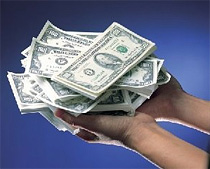“If you connect all these dots, you can tell that the government is indeed pushing forward investment abroad, although the pace could be bolder,” says Xu Mingqi, a professor at the Shanghai Academy of Social Science.
Does it mean that the Holy Grail of forex – a fully convertible RMB – will occur soon? “There is no timetable,” says Mu. “What I can tell you is that once you start the acceleration, there is no turning back.”
Forced to Evolve
SAFE has had no choice but to evolve. The cost of regulatory control has already increased to a point that SAFE officials say is too high, while monitoring the ever increasing flow of funds has proven to be almost impossible. Despite strict controls, some US$200 billion of inflows was unaccounted for in 2008. “The high diversity of funds flowing into China makes checking every item impossible,” says Mao.
That is no surprise, given the amount of money involved. In 2008, outbound investment from China was US$18.7 billion, equal to about one-third of its total outbound investment since the country opened its doors to the outside world 30 years ago. Outbound investment in 2009 is estimated to be even higher since many Chinese companies have used the financial crisis to buy assets overseas. However, compared with its US$2.1 trillion in foreign currency reserves, outbound investment remains a small fraction of the total. In the first 11 months of 2009, inbound foreign direct investment (FDI) reached US$78 billion.
The change in attitude at SAFE, modest though it may be, is the result of a major shift in China’s position in global trade when fears of a forex shortage were replaced with fears of a massive surplus. All that began after the Asian financial crisis in 1997, when SAFE was given the mandate to accumulate as much forex as possible. “At the time, we had only about US$100 billion [in forex reserves],” says a senior SAFE official. That’s when the institution launched its policy of — in the words of the official — ‘Welcome inflows of foreign investment but strictly control outflows.’”
Mao recalls the growing concerns at the time vividly. In 1998, he says, a Shanghai company sent an application to SAFE’s office in Shanghai to exchange US$20,000, which it needed for an overseas investment. The company couldn’t find any way to secure the small amount overseas and the deal was on the verge of collapsing. The Shanghai office passed the application to SAFE’s Beijing headquarters for approval, and the request was denied.
Mao then suggested that the company send a team of executives to the country where it was doing business, and have each of them exchange some cash. “It was the only alternative I could think of,” says Mao. “With each member of the team entitled to convert some renminbi into U.S. dollars, they could at least pool the necessary US$20,000 in cash.”
The major shift began in 2004, one year before China loosened the RMB peg to the U.S. dollar. “At the time, the idea was to change from the wholesale welcome of all FDI to balanced management of foreign currency inflows and outflows,” says the senior official. In 2004, SAFE introduced Measure 104 so that, for the first time, qualified foreign companies were able to transfer cash overseas to their headquarters or to related companies via entrusted loans. However, SAFE set the threshold high: The firms needed to have three legal entities invested in China and the funds being sent overseas were restricted to their own local currency. Moreover, approval was required for all cases.
In general, SAFE has slowly shifted responsibility for reviewing and processing corporate applications on to the banks so that it can focus more on assessing the investment flows afterwards.
However, these changes were baby steps compared with the rapid changes taking place in business generally. The expectation of gradual RMB appreciation led to inflows of “hot money” seeking high returns, which fuelled asset bubbles in China. At the same time, China’s trade surplus rose dramatically and as a result, its foreign currency reserves, mostly denominated in U.S. dollars, have reached record highs every year since. China’s foreign currency reserves changed from an economic necessity to a hot potato.
One way to alter the balance was to encourage more overseas investment. That’s why since 2006
A Cautionary Tale
The setback illustrates the pitfalls of the liberalization process, says the official. “It showed how small incidents can derail major initiatives and that we all need to be very careful in pushing forward any significant changes,” he says.



